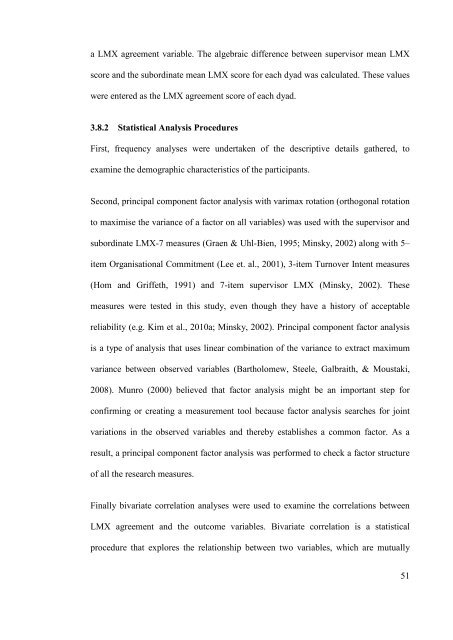View/Open
View/Open
View/Open
Create successful ePaper yourself
Turn your PDF publications into a flip-book with our unique Google optimized e-Paper software.
a LMX agreement variable. The algebraic difference between supervisor mean LMX<br />
score and the subordinate mean LMX score for each dyad was calculated. These values<br />
were entered as the LMX agreement score of each dyad.<br />
3.8.2 Statistical Analysis Procedures<br />
First, frequency analyses were undertaken of the descriptive details gathered, to<br />
examine the demographic characteristics of the participants.<br />
Second, principal component factor analysis with varimax rotation (orthogonal rotation<br />
to maximise the variance of a factor on all variables) was used with the supervisor and<br />
subordinate LMX-7 measures (Graen & Uhl-Bien, 1995; Minsky, 2002) along with 5–<br />
item Organisational Commitment (Lee et. al., 2001), 3-item Turnover Intent measures<br />
(Hom and Griffeth, 1991) and 7-item supervisor LMX (Minsky, 2002). These<br />
measures were tested in this study, even though they have a history of acceptable<br />
reliability (e.g. Kim et al., 2010a; Minsky, 2002). Principal component factor analysis<br />
is a type of analysis that uses linear combination of the variance to extract maximum<br />
variance between observed variables (Bartholomew, Steele, Galbraith, & Moustaki,<br />
2008). Munro (2000) believed that factor analysis might be an important step for<br />
confirming or creating a measurement tool because factor analysis searches for joint<br />
variations in the observed variables and thereby establishes a common factor. As a<br />
result, a principal component factor analysis was performed to check a factor structure<br />
of all the research measures.<br />
Finally bivariate correlation analyses were used to examine the correlations between<br />
LMX agreement and the outcome variables. Bivariate correlation is a statistical<br />
procedure that explores the relationship between two variables, which are mutually<br />
51

















